
Thrifty and fruit coconut, raspberry and chocolate muffins
The combination here tastes wonderful whether you’re using fresh raspberries in season (when they’re cheaper) or frozen raspberries,” says former Great British Bake Off contestant Hermine Dossou. “To enhance the flavour of your desiccated coconut, you could toast it lightly (for five minutes or so) while preheating the oven – but keep an eye on it as it does turn brown very quickly.” Coconut, raspberry and chocolate muffins Makes: 12 Ingredients: 180g milk 2 large eggs 60g vegetable oil 60g unsalted butter, melted 230g sugar 1 tsp vanilla extract ½ tsp ground cinnamon ½ tsp ground nutmeg 5g salt 250g plain (all-purpose) flour (gf plus ½ tsp xanthan gum) 80g desiccated (dried shredded) coconut 10g baking powder (gf) 150g raspberries 150g milk chocolate, chopped into chunks Method: 1. Preheat the oven to 200C/180C fan/400F/gas 6 and line a 12-hole muffin tin with paper cases. 2. In a large mixing bowl, mix together the milk, eggs, oil, butter, sugar, vanilla, cinnamon, nutmeg and salt for about a minute, until well combined. Add the flour, coconut and baking powder and stir until fully incorporated. Fold in half the raspberries and all the chocolate chunks. 3. Divide the batter equally between the muffin cases. Top each muffin with a couple of the remaining raspberries. Bake for 25–30 minutes, or until the muffins have risen and are golden brown. You can keep these for a few days in an airtight container, or, once cooled, freeze them for up to 3 months. They are lovely served warm – either out the oven or reheated for a few seconds in the microwave. ‘The Thrifty Baker’ by Hermine Dossou (White Lion, £18.99).
2023-09-06 13:50

Three ways to pimp up university student classics
As teenagers start or head back to university this month, we’ve found three ways to level up student classics: instant ramen, ravioli and baked beans. Pre-made food has never tasted this good. As part of our Budget Bites column – where we’ve teamed up with Sorted Food to bring you easy, affordable, quick and (most importantly) tasty recipes once a month – this month’s instalment is all about dishes that make the most of staple ingredients while keeping your fresh shopping list minimal. We’ve also provided a handy shopping list for the ingredients (though hopefully most of it will be knocking about already), which are used across all recipes to ensure minimal food waste. You just need to decide where to shop, whether it’s locally or online. Shopping list 2 baking potatoes (large) 6 cloves garlic 20g fresh ginger 20g fresh chives 60g rocket 200g fresh spinach 200g chestnut mushrooms 125g cheddar 30g unsalted butter 250g spinach and ricotta ravioli 2 instant ramen packets 400g tinned baked beans 1.5 tbsp gochujang 3 tbsp sesame oil 3 tbsp vegetable oil 1 tbsp cider vinegar 1 tsp mild chilli powder 1 tbsp tahini 2 tbsp light soy sauce 1 tsp honey Instant green ramen with sticky soy minced mushrooms If you aren't a fan of mushrooms, try replacing them with crumbled firm tofu. Serves: 2 Ingredients: 200g chestnut mushrooms 3 tbsp vegetable oil 2 instant ramen packets 2 cloves garlic 200g fresh spinach 20g rocket 1 tbsp tahini 2 tbsp light soy sauce 1 tsp honey Method: 1. Fill the kettle with water and put it on to boil, this will be for the broth and noodles later. 2. Mince 200g of mushrooms on a chopping board like you might chop herbs, until rice-like in size. You can use a food processor here if you are low on time. 3. Add 3 tbsp of oil to a large frying pan and place it over a high heat. 4. Once the oil starts to shimmer and loosen, add the mushrooms. Fry, tossing occasionally for 8-10 minutes, until golden in places. Get on with the rest of the dish in the next steps while you wait. 5. Tip the flavour sachets from 2 packets of instant noodles into a medium saucepan. Peel, then finely grate in 2 cloves of garlic and add 700ml of boiling water from the kettle. 6. Place the pan over a high heat, then add 200g of spinach and 20g of rocket. Boil for 4-5 minutes, stirring occasionally until the spinach wilts, darkens, and softens fully. Get on with the rest of the dish in the next steps while you wait. 7. Add the noodles from the packets to another medium saucepan and cover with boiling water from the kettle. 8. Place the pan over a high heat and boil for 2-3 minutes, until soft but still with a slight bite. Get on with the rest of the dish in the next steps while you wait. 9. Once the spinach has darkened and wilted, take the pan off the heat, add 1 tbsp of tahini and blitz until smooth and bright green with a hand blender. You have made your green broth! 10. Once the noodles are ready, use tongs to transfer them straight into bowls. Pour over the green broth and turn your attention back to the mushrooms. 11. Add 2 tbsp of soy sauce and 1 tsp of honey to the mushrooms. Cook over a high heat for 1-2 minutes, tossing regularly, until dark and sticky. 12. Spoon the mushrooms over the noodles and tuck in! Pre-made ravioli cheddar cacio e pepe We use spinach and ricotta ravioli in this recipe, but feel free to get creative and use different pre-made filled pastas. Serves: 2 Ingredients: 75g cheddar 10g fresh chives 30g unsalted butter 2 cloves garlic 1 tsp mild chilli powder 250g spinach and ricotta ravioli Method: 1. Fill the kettle with water and put it on to boil. This will be for the pasta later. 2. Coarsely grate 75g of cheddar, then finely chop 10g of chives crossways on the same board - we will need these later. 3. Melt 15g of the butter in a small pan over a low heat. 4. Once the butter starts to foam, peel and finely grate in 2 cloves of garlic and add 1 tsp of mild chilli powder. Take the pan off the heat and allow everything to cook and infuse in the residual heat while you get on with the rest of the dish in the next steps. 5. Add 250g of ravioli to a medium saucepan and cover with boiling water from the kettle. Place the pan over a high heat. 6. Cook for 3-4 minutes, until the pasta is soft and the filling is piping hot. Get on with the rest of the dish in the next steps while you wait. 7. Grind 1 tbsp of pepper into a large frying pan, toast it over a medium heat for 2-3 minutes, tossing occasionally, until fragrant. 8. Add the remaining 15g of butter to the pepper and allow it to melt in the pan. 9. Once the ravioli is ready, use a slotted spoon to transfer it to the pan with the pepper and butter. Toss and swirl everything to create a loose emulsion of the butter and pasta water around the ravioli. 10. Take the pan off the heat and toss through the cheese - add a splash of pasta water if it starts to look a little sticky or thick. We are looking for a loose emulsion of the cheese, butter, and pasta water at this stage. 11. Divide the pasta between plates. Drizzle over the garlic chilli butter and scatter over the chives. Gochujang baked bean jacket potatoes These levelled-up baked beans also taste great on toast or wrapped in crispy puff pastry! Serves: 2 Ingredients: 2 baking potatoes (large) 400g tinned baked beans 1.5 tbsp gochujang 2 cloves garlic 20g fresh ginger 3 tbsp sesame oil 50g cheddar 10g fresh chives 40g rocket 1 tbsp cider vinegar Method: 1. Preheat the oven to 230C. 2. Stab 2 baking potatoes all over with a fork. Cook in the microwave on full power for 10-12 minutes, until soft throughout. Flip them over halfway through to ensure an even cooking. Get on with the rest of the dish in the next steps while you wait. 3. Add 1 400g tin of baked beans to a medium saucepan. Add 1 ½ tbsp of gochujang, then peel and finely grate in 2 cloves of garlic and 20g of ginger. 4. Place the pan over a low heat, slowly bring the beans up to a simmer, and cook for 4-5 minutes, until piping hot. 5. Once the potatoes are ready, transfer them to a small baking tray. Rub with 2 tbsp of the sesame oil and a generous pinch of salt. 6. Bake in the oven for 8-10 minutes, until the skin is crisp and golden. Get on with the rest of the dish in the next steps while you wait. 7. Coarsely grate 50g of cheddar, then finely chop 10g of chives crossways on the same board. 8. Add 40g of rocket to a large mixing bowl, toss with 1 tbsp of sesame oil, 1 tbsp of vinegar, and a pinch of salt. If you are still waiting for the potatoes, now would be a great time to crack on with a bit of washing up. 9. Once the potatoes are ready, split them lengthwise in half and fill with the baked beans. Scatter over the cheese, chives, and serve with the salad. In response to the rising cost of living, we have teamed up with Sorted Food to bring you easy, affordable, quick and (most importantly) tasty recipes once a month. Find out more about Sorted and their nifty meal-planning app Sidekick at sortedfood.com/sidekick. Read More Epicurus: American fast food meets the Middle East in Camden Market The dish that defines me: Evelin Eros’s rum cake ‘It started with a radish’: Chef Simon Rogan reflects on restaurant L’Enclume at 20 The true story – and murky history – of Portuguese piri piri oil ‘My depression stopped me doing what I loved most in life – cooking’ What Bake Off’s Jurgen Krauss really thinks of his shock elimination
2023-09-05 20:25
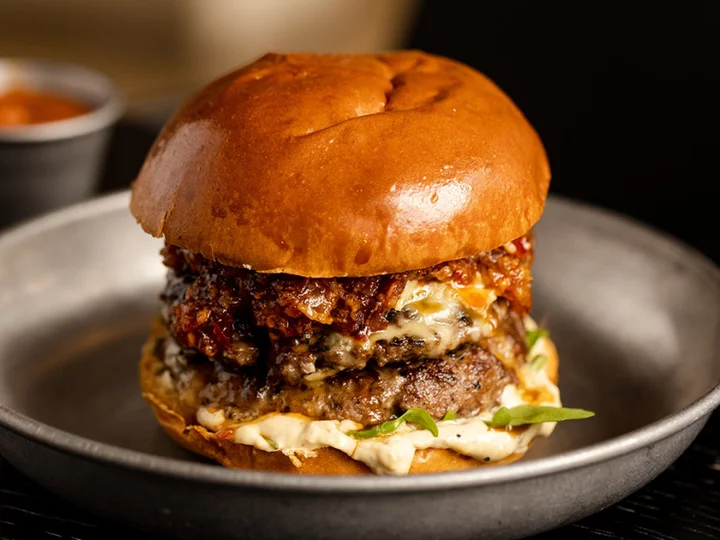
Epicurus: American fast food meets the Middle East in Camden Market
Camden has long been known as the spiritual home for misfits. Come, all ye oddballs, the streets of Camden scream. All are welcome! Although nowadays it’s a little less punk haven and a little more tourist trap (yes, I’m looking at you, pastas dunked into cheese wheels), there are still pockets of Camden that have retained its unconventional charm. It’s also where punky pair and Israeli chefs Shiri Kraus and Amir Batito have set up shop for both their restaurants, The Black Cow and the newer Epicurus, just minutes away from each other. Like The Black Cow, modeled after the classic American steakhouse but infused with Middle Eastern flavours, Epicurus takes its culinary cue from across the pond. This time, Kraus and Batito decided to focus on the all-American diner and put their Israeli twist on classics like pancakes, wings and ribs. When I ask if this is because American food is a bit of a blank slate, Kraus swiftly corrects me; to her, it’s all about the excitement of infusing the character of American cuisine with Israeli flavours and seeing what’s possible. It’s a pairing that I think is unusual, but to the chefs, makes perfect sense. It’s a warm, balmy day when I make my way to Epicurus to meet my friend, as well as Kraus and Batito. The outdoor space is placed tantalisingly in the late afternoon sun, so we bask in it as our tiny table fills up with more plates than is sensible. The quirky menu features punny dish names like “Chip Chip Hooray”, “Raspoutine”, “Top Dog” and “Sloppy Yossef”, which I find immediately endearing – my love for a good (or even bad) puns knows no bounds. We are instructed to eat as many things as possible with our hands, although Kraus concedes: “You could use a fork, I’ll only judge in silence.” We find delight in the “Oof Gozal” – chicken wings coated in a yellow Amba mango and Scotch bonnet sauce. Despite the use of the fearsome chilli, these wings are barely spicy, favouring the flavour of the Scotch bonnet over the heat. They are incredibly moreish and the fact that your fingers end up being absolutely covered in sauce is only an invitation to get licking. You should also definitely get the “Papi Chulo”, a mix of crunchy deep-fried okra and soft padron peppers covered in spices that come with a lemony-garlicky-chilli aioli for dipping. It’s brilliant for snacking on in the sun. Another honourable mention goes to the Epicurus single decker burger, which is also available as a double. It contains some of the richest, fattiest ingredients I’ve ever seen between buns, like bone marrow aioli and Baron cheese, and it does border on being a bit too unctuous. The Harissa bacon jam helps pull it back a little, but only just. Would I eat it again? Definitely. But I probably would get a salad instead of chips to make myself feel slightly better about ingesting all that fat. I am usually glad when menus don’t have calorie counts – even when they do, I avert my gaze determinedly – and boy, am I really glad there’s no calorie count on this menu. Not everything hits the spot, which I’m hoping Kraus and Batito will be able to tweak until they do. The “Dakdakim”, pancakes stuffed with pulled shawarma chicken, has the trappings of something great, but the addition of both bacon jam and spiced quince make the dish too sickly sweet. Meanwhile, the rack of babyback ribs covered in a deliciously tart-yet-sweet date honey and pomegranate molasses needs a bit more fat on the bones to make it truly delectable – otherwise the mouth-puckering quality of the sauce make the too-lean ribs a bit too dry to really enjoy. But these are small gripes, and ones that I’m happy to forgive if they are improved upon. Is it worth elbowing your way through the thronging crowds of Camden Lock Market to get to Epicurus? I think it will be. Never mind the cheap tat and endless boba tea shops (most of which are simply not very good, there are better places to visit boba tea that isn’t just a sugar bomb) – head to Epicurus for a tasty escape. Epicurus, Unit 90, Camden Stables Market, Greater, London NW1 8AH | www.epicuruscamden.co.uk | 07843 199560 Read More Dorshi, Dorset: Funky Malaysian dumplings are a hit on the south coast National Burger Day 2023: The best burgers in London and where to eat them The best outdoor restaurants, terraces and rooftop bars in London to book now
2023-09-02 19:20

David Bowie’s fashion daughter Lexi declares art has helped her out of ‘dark places’
After the singer’s cancer death in 2016,David Bowie’s fashion designer daughter Alexandria Zahra Jones has says making art helped her battle mental health issues.
2023-09-01 19:27
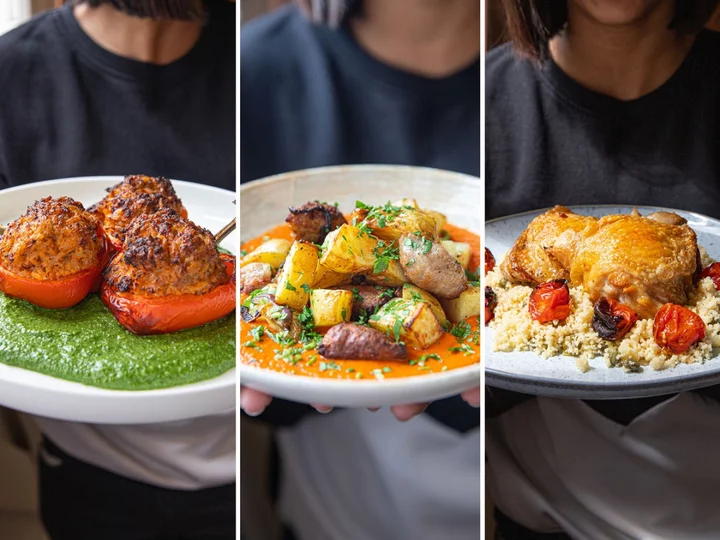
Still not sold on air fryers? Let these recipes prove their worth
We’re all sick of hearing about them by now, but air fryers are still enjoying “a moment”. They can also really help reduce the time and energy it takes to make a dish, so we’ve teamed up with the culinary geniuses at Sorted and used this piece of magical kit to cook up three dishes that use it in three different ways. From deeply savoury cheesy sausage-stuffed peppers with vibrant spinach pesto, to hearty and comforting potato and sausage hash with a smoky tomato sauce, these recipes not only showcase the versatility and convenience of air fryers, they’re also pretty damn delicious. Not to forget the crispy chicken thighs and tomatoes with lemon, caper and almond couscous, which demonstrates the art of achieving both crispiness and succulence without the oil. Go forth and revolutionise. Cheesy sausage-stuffed peppers with spinach pesto We use red peppers in this recipe, but if you can’t find them, use any colour of bell pepper to your liking. Serves: 2 Ingredients: 3 red bell peppers 4 tbsp olive oil 250g microwave brown rice 120g cream cheese 1 tbsp tomato purée/tomato paste 4 pork sausages 100g cheddar 200g fresh spinach 30g almond flakes 1 clove garlic 15g fresh parsley 1 lemon Method: 1. Preheat the air fryer: preheat the air fryer to 200C. 2. Prep the peppers: cut 3 bell peppers in half lengthways and scoop out all the seeds from their centres. Rub the peppers with 4 tbsp of olive oil on the board and season with salt. 3. Assemble the filling: crumble 250g of cooked brown rice into a large mixing bowl. Add 120g of cream cheese and 1 tbsp of tomato paste, then coarsely grate in 25g of the cheddar - we will use the rest later. Squeeze in the meat from the casings of 4 sausages. 4. Mix it up: season with salt and pepper, then fold everything together, ensuring the sausage meat breaks up and is well dispersed through the mix. 5. Fill the peppers: divide the mix between the oiled pepper cups - there is no need to press and compact the mixture into the peppers. 6. Fry: pop the pepper halves in the draw of the air fryer, filling side up, and cook for 17-20 minutes until golden in places and piping hot throughout. When cut into, the sausage shouldn’t be pink. Get on with the rest of the dish in the next steps while you wait. 7. Get the spinach ready: add 200g of spinach to another mixing bowl and cover with cling film. 8. Cook the spinach: microwave on full power for 3-4 minutes, until darkened and wilted. 9. Assemble the pesto: once the spinach is ready, add 30g of almond flakes, 1 peeled garlic clove and 15g of parsley to the bowl. Coarsely grate in the remaining 75g of cheddar, then finely grate in the zest from 1 lemon, and squeeze in its juice. 10. Blend it up: blitz everything together with a hand blender, until smooth. Season to taste with salt and pepper. If you are still waiting for the peppers, now would be a great time to crack on with a bit of washing up. 11. Serve: divide the pesto between plates and spread it out to form discs. Top with 3 pepper halves per portion and tuck in. Potato and sausage hash with smoky tomato sauce This recipe can be vegetarian-ised by using veggie sausages instead! Serves: 2 Ingredients: 600g loose white potatoes 1 red onion 4 pork sausages 4 tbsp olive oil 4 cloves garlic 1 tbsp smoked paprika 400g tinned chopped tomatoes 15g fresh parsley 45g cream cheese Method: 1. Preheat: preheat the air fryer to 200C. 2. Prep the potatoes and onions: Cut 600g of potatoes into bite-sized chunks, then halve, peel and roughly slice 1 red onion. Add the veg to a large mixing bowl. 3. Add the sausage: squeeze the meat from the casings of 4 sausages into the bowl, creating little meatballs as you pinch them off. 4. Oil and toss: toss everything with 2 tbsp of the oil and a generous pinch of salt. Remember to wash your hands after handling raw meat. 5. Fry: tip the oiled potatoes, onions, and sausage balls in the draw of the air fryer and cook for 20-25 minutes, until golden in places and the potatoes are soft throughout. Give everything a toss halfway through cooking to ensure an even colouring. Get on with the rest of the dish in the next steps while you wait. 6. Prep the garlic: peel and mince 4 cloves of garlic. Add them to a medium saucepan along with the remaining 2 tbsp of olive oil. 7. Fry: place the pan over a medium heat and slowly fry for 2-3 minutes, until the garlic starts to colour. 8. Add the paprika: add 1 tbsp of smoked paprika and fry for a further 20-30 seconds, until very fragrant. 9. Add the tomatoes: add 1 400g tin of chopped tomatoes to the pan along with a generous pinch of salt. 10. Simmer down: simmer for 6-8 minutes, until reduced by S. Get on with the rest of the dish in the next steps while you wait. 11. Chop the parsley: finely chop 15g of parsley, then crack on with a bit of washing up while you wait for the sauce. 12. Blend: once the tomatoes have reduced by S, add 45g of cream cheese and blitz until smooth with a hand blender. 13. Serve: divide the sauce between plates and top with the fried potato, onion, and sausage. Scatter over the chopped parsley and serve. Air fryer crispy chicken thighs and tomatoes with lemon, caper and almond couscous If you aren’t into capers, you can leave them out or replace them with green olives. Serves: 2 Ingredients: 4 chicken thighs, bone-in, skin-on 200g cherry tomatoes 3 tbsp olive oil 150g couscous 2 tbsp capers 20g almond flakes 1 lemon Method: 1. Preheat: preheat the air fryer to 200C. Fill the kettle with water and put it on to boil - this will be for the couscous later. 2. Oil and season: add 4 chicken thighs to a large mixing bowl along with 200g of tomatoes. Toss with 2 tbsp of the olive oil and a generous pinch of salt, ensure everything is fully coated. 3. Get ready to cook: add the tomatoes and chicken to the tray of the air fryer. Ensure the chicken thighs are positioned on top of the tomatoes, skin-side up. 4. Cook: cook for 20-25 minutes, until the chicken’s skin is crispy and the tomatoes are soft and jammy. Get on with the rest of the dish in the next steps while you wait. 5. Assemble the couscous: add 100g of couscous, 2 tbsp of capers, 15g of the almond flakes, the remaining 1 tbsp of oil and a generous pinch of salt to another large mixing bowl. 6. Add the water: add enough boiling water from the kettle to just cover the grains, then give everything a quick stir. 7. Cook the couscous: set aside to cook the couscous for 6-8 minutes, until the grains are soft and have absorbed all the water. Crack on with a bit of washing up while you wait. 8. Finish the couscous: once the couscous is ready, finely grate over the zest from 1 lemon and squeeze in its juice. Fluff the grains with a fork and fold everything together. 9. Serve: divide the couscous between plates and top with the tomatoes and chicken. Scatter over the remaining 5g of almond flakes and serve. Find out more about Sorted and their nifty meal-planning app Sidekick at sortedfood.com/sidekick. Read More The dish that defines me: Evelin Eros’s rum cake ‘It started with a radish’: Chef Simon Rogan reflects on restaurant L’Enclume at 20 The true story – and murky history – of Portuguese piri piri oil ‘My depression stopped me doing what I loved most in life – cooking’ What Bake Off’s Jurgen Krauss really thinks of his shock elimination How to pull off a traditional German babka chocolate braid
2023-08-31 13:45

Rising caffeine levels spark calls for ban on energy drink sales to children
By Kailyn Rhone Pediatricians and parents are calling for the U.S. to treat new high-caffeine energy drinks like
2023-08-30 18:51
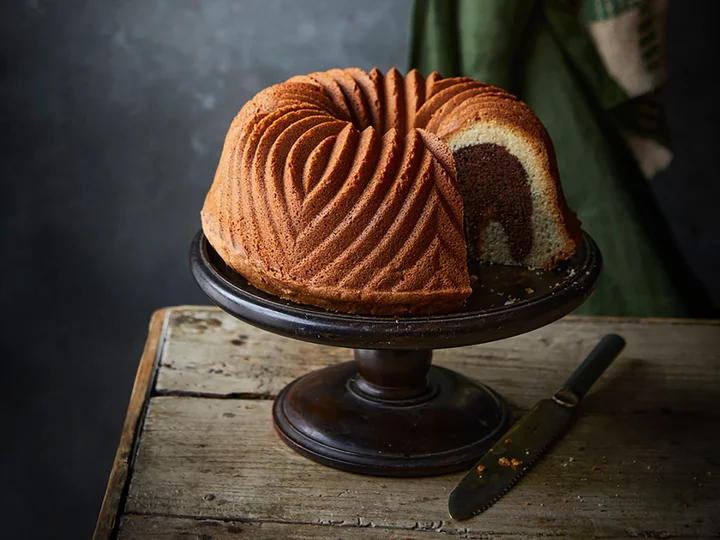
Quick, moist and flavourful: Jurgen Krauss’s marble cake
This cake was a standard on our Sunday coffee table and has a lot of nostalgia for me. It is quick to make, moist and flavourful, and the marble pattern was always fascinating to me as a child,” says former contestant on The Great British Bake Off, Jurgen Krauss. Marble cake Serves: 12-24, depending on tin size. The amounts given are for a loaf tin (950g) or a Bundt tin. For a bigger Bundt tin, double the amounts and bake for 15 minutes longer. Ingredients: For the batter: 125g unsalted butter or margarine, room temperature 2 tsp vanilla extract 2 eggs, separated 180g caster sugar 250g plain flour 8g baking powder 125ml whole milk For the chocolate batter: 10g cocoa powder 15g caster sugar 25ml double cream ¼ tsp ground cloves Method: 1. Preheat the oven to 170C fan/gas mark 5. 2. Put the butter in a bowl and, using a hand mixer or a stand mixer fitted with the balloon whisk, beat the butter until it is light and pale. Add the vanilla extract and egg yolks, alternating with the sugar bit by bit, and whisk for another 15 minutes until the butter and sugar mix is very frothy and white. 3. Sift the flour and baking powder together in a bowl. Alternate adding the flour and milk bit by bit to the batter while whisking on a low speed. 4. In a separate bowl, whisk the egg whites to soft peaks. Fold the egg whites into the butter and flour mixture. 5. For the chocolate batter, take one third of the plain batter and put it into a separate bowl. Fold in the ingredients for the chocolate batter. Put the two batters in a greased 950g Bundt tin or a loaf tin, starting with the vanilla batter, then add a layer of chocolate batter and finish with vanilla batter. Use a fork to create the marble effect by pulling it through the layers of batter with a swirling motion. Bake for about one hour; the cake should start separating from the tin and a skewer inserted into the cake should come out clean. Cover with foil if the top of the cake starts getting too dark. 6. Leave the cake to cool in the tin for at least 20 minutes before attempting to take it out of the tin. 7. This cake keeps very well for up to a week in an airtight container and for the first three days its flavour actually improves. ‘German Baking: Cakes, Tarts, Traybakes And Breads From The Black Forest And Beyond’ by Jurgen Krauss (published by Kyle Books on 31 August, £26). Read More The dish that defines me: Evelin Eros’s rum cake ‘It started with a radish’: Chef Simon Rogan reflects on restaurant L’Enclume at 20 The true story – and murky history – of Portuguese piri piri oil ‘My depression stopped me doing what I loved most in life – cooking’ What Bake Off’s Jurgen Krauss really thinks of his shock elimination How to pull off a traditional German babka chocolate braid
2023-08-30 14:00
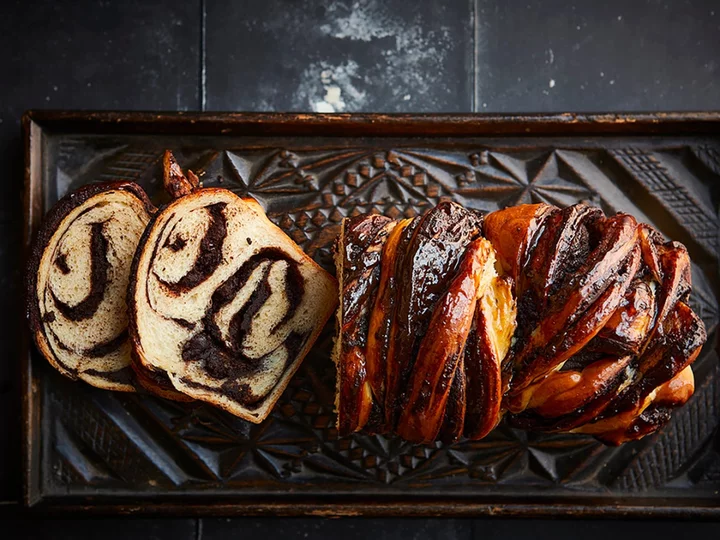
How to pull off a traditional German babka chocolate braid
What looks more stunning than the randomly swirling bands of dark chocolate in this loaf of white sweet bread? This style of braiding is known in many countries, and is used with different fillings as well,” says former contestant on The Great British Bake Off, Jurgen Krauss. “Always an eye-catcher, it used to be a special treat on our Saturday afternoon coffee table. The rich spices and citrus zest in combination with chocolate make this truly a great braid for any special occasion.” Babka chocolate braid Serves: 15 Ingredients: For the dough: 190g bread flour 140g white spelt flour or plain flour, plus extra for dusting 6g instant yeast 1 pinch salt 40g caster sugar 180ml whole milk 1 medium egg 40g unsalted butter, softened Zest of 1 lemon Zest of 1 orange ½ tsp ground cardamom For the filling: 100g dark chocolate (54% or 70% cocoa solids, to taste) 60g unsalted butter 60g soft light brown sugar 2 tsp ground cinnamon ½ tsp ground cloves 30g cocoa powder Unsalted butter, melted, or apricot jam for glazing Method: 1. For the dough, put all the ingredients in a bowl and, using your hands or a stand mixer fitted with the dough hook, mix the ingredients until evenly distributed. Then knead the dough for several minutes until it has a smooth and silky texture. Cover with a tea towel or a plastic bag and leave to prove at room temperature for about one hour. Check with the poke test that the dough is ready. 2. Meanwhile, prepare the filling. Put the chocolate, butter and sugar into a pan and melt over low heat. Once liquid, take the pan off the heat and add the cinnamon, cloves and cocoa powder. It’s OK if the filling looks grainy. 3. Line a 950g loaf tin with baking paper. 4. On a lightly floured surface, roll out the dough to a rectangle measuring about 50 x 30cm. Spread the chocolate filling over the dough rectangle, leaving 2cms of the far short edge uncovered. Roll up the dough rectangle, starting at the near short edge. Seal the seam by pinching it. 5. Place the roll on a work surface with the seam facing down and, with a sharp knife, cut the roll lengthwise into halves. Twist the halves together to form a rope. You can do this starting at one end and twist this half of the roll, and then do the same for the other half; this way you don’t have to manipulate the whole length at once. 6. Place your hands palm down on the ends and, with a scooping movement, bring the ends to meet underneath the middle of yourrope. Transfer this into the lined tin, and cover with a tea towel or a plastic bag. Leave to prove for 30 minutes to one hour until the Babka is well risen and the dough starts to feel fragile; a gentle touch with a finger will leave a dent that only slowly recovers. 7. Preheat the oven to 170C fan/gas mark 5. 8. Bake the babka for 30-40 minutes. 9. Melt the butter for glazing or heat the apricot jam with a teaspoon of water. Brush the babka with melted butter or jam as soon as it is out of the oven. Leave to cool for about 15 minutes, then carefully remove from the tin and baking paper. 10. Let the babka cool completely before eating. Stored in an airtight container it will last for three days. ‘German Baking: Cakes, Tarts, Traybakes And Breads From The Black Forest And Beyond’ by Jurgen Krauss (published by Kyle Books on 31 August, £26). Read More The dish that defines me: Evelin Eros’s rum cake ‘It started with a radish’: Chef Simon Rogan reflects on restaurant L’Enclume at 20 The true story – and murky history – of Portuguese piri piri oil ‘My depression stopped me doing what I loved most in life – cooking’ What Bake Off’s Jurgen Krauss really thinks of his shock elimination Quick, moist and flavourful: Jurgen Krauss’s marble cake
2023-08-30 13:49
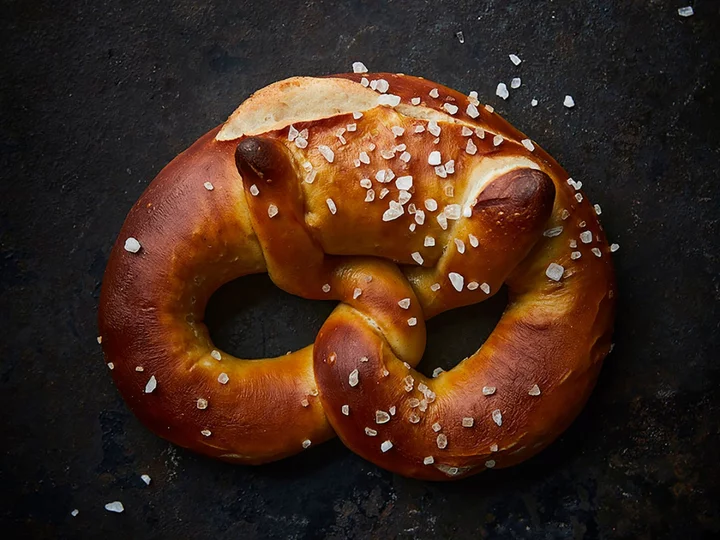
Knotty and nice: Jurgen Krauss’s homemade soft pretzel recipe
Pretzels, or brezel or brezen in German, are the most iconic German food. Ornaments of pretzels adorn every bakery, and images of them can be found on medieval church windows in Freiburg, where I come from,” says former contestant on The Great British Bake Off, Jurgen Krauss. “Often, a pretzel works better as a soother for an upset baby than a dummy. They are a part of my upbringing and heritage. And still, there is no better snack after a long shopping spree through my hometown of Freiburg than a brezel from the bakery at the tram stop. “Disclaimer about lye: I am giving two options for the finish. One is using lye, which involves a very dangerous chemical, solid sodium hydroxide. The other option uses baking soda, which is bicarbonate of soda, and is not dangerous at all. The results are different in colour and taste, but without a direct comparison, the bicarbonate of soda pretzel can stand its ground. If you intend to use lye, I’d recommend baking a few batches of pretzels with bicarbonate of soda, but treat it as if it was lye, to practise the handling and have everything in the right place before starting.” Soft pretzel Makes: 8-10 Ingredients: For the starter: 100g bread flour 2g salt 1⁄8 tsp instant yeast 65ml water For the dough: 400g bread flour 9g salt 20g honey 5g instant yeast 25g unsalted butter, room temperature 180ml water Coarse salt crystals, for sprinkling For the lye or bicarb dipping solution: 2L water 8g salt 80g bicarbonate of soda or 80g sodium hydroxide pellets Method: 1. Prepare the starter the day before baking. Combine all the ingredients in a bowl and mix with your hand or a spatula until all the flour is incorporated. Cover with clingfilm and leave to stand at room temperature for about two hours. Then put the starter in the fridge overnight until you need it – it will be good to use for up to three days. 2. About one hour before making the main dough, take the starter out of the fridge. 3. To make the main dough, combine all the ingredients except the salt crystals and the starter in a bowl and mix with your hand or a spatula. The resulting dough will be very stiff. Knead the dough on a work surface for about 10 minutes. Don’t use any additional flour, you won’t need it anyway. The resulting dough should be smooth and a bit elastic. Put the dough into a bowl, cover and prove at room temperature for about two hours. Fold the dough once after one hour. 4. Meanwhile, prepare the dipping solution. Use a big stainless-steel pan and stainless-steel spoons for dipping. Cover your normal work surfaces in case the lye spills. When dipping, keep the baking sheets very close to the lye pan and the oven. Always wear protective gloves and goggles when working with sodium hydroxide and lye. Never ever touch sodium hydroxide pellets with your skin. 5. If using bicarbonate of soda, bring the water to boil. Switch off the heat, add the salt and stir. Then add the bicarbonate of soda – there will be a bit of frothing and splashing, so be careful. Leave to cool. 6. If using sodium hydroxide, put the water in the pan and then add the sodium hydroxide pellets. Sodium hydroxide creates a lot of heat when it dissolves. 7. Once the dough has proved, divide it into pieces weighing 85 grams each. Roll each piece of dough into a cylinder. Once all the pieces have been rolled, start again with the first piece, to roll it into a long strand with thin ends and a belly in the middle. Aim for a length of 60 centimetres. Make sure you don’t tear your strands – if there is too much resistance in the dough, move on to the next strand. You will need several cycles to reach the length required. 8. Now shape the pretzels – the bakers use a slinging method, but there is a simpler, slower way to do this. Make sure the ends of the little arms are well attached to the middle bit. 9. Place the pretzels onto lined baking trays, cover and leave to prove at room temperature for about 45 minutes. Uncover the pretzels and put them in the fridge for 30 minutes, so that a skin can form. Preheat the oven to 230C fan/gas mark 9. 10. Take the pretzels out of the fridge. Dip each pretzel in lye or sodium carbonate solution for about five seconds. Transfer the pretzel back onto the lined baking sheet. One sheet will hold four to five pretzels. Once the sheet is full, slash the thickest part of the pretzels with a sharp serrated knife and sprinkle with salt crystals. Transfer to the oven immediately and bake for 12–15 minutes. Leave to cool on a wire rack. Repeat with the remaining pretzels. 11. Because of the salt, these pretzels are best eaten fresh. ‘German Baking: Cakes, Tarts, Traybakes And Breads From The Black Forest And Beyond’ by Jurgen Krauss (published by Kyle Books on 31 August, £26). Read More The dish that defines me: Evelin Eros’s rum cake ‘It started with a radish’: Chef Simon Rogan reflects on restaurant L’Enclume at 20 The true story – and murky history – of Portuguese piri piri oil ‘My depression stopped me doing what I loved most in life – cooking’ What Bake Off’s Jurgen Krauss really thinks of his shock elimination How to pull off a traditional German babka chocolate braid
2023-08-30 13:47

What Bake Off’s Jurgen Krauss really thinks of his shock elimination
Jurgen Krauss’s elimination from the 2021 Great British Bake Off caused such a scandal, Ofcom received 115 viewer complaints. The lovable German baker was seen as a top competitor, winning three star baker prizes before being booted off in the semi-finals. Nearly two years on, Brighton-based Krauss, 58, has no hard feelings – but he did see the uproar coming. “I had a feeling there would be complaints – a feeling that people would take it very seriously,” he says. But he still has only good things to say about the show, noting the “overwhelmingly positive reaction was quite amazing”, and crediting the experience with boosting his baking skills massively. He speaks particularly fondly about the period before the competition started, when the contestants were in a bubble and testing their recipes. “We had nine weeks to prepare one signature and one showstopper each week and submit the recipe – that was really a huge time for growth,” he says. He calls this a period of “non-stop new ideas, non-stop new processes”, adding with a wry laugh: “Most of the things I’d done in the tent I’d never done before, and some of them I’ve never done since, [and] I’m not sure I’ll ever do them again. It was tough – it was amazing.” Many of the bakes Krauss made on the show were inspired by his childhood in the Black Forest, Germany. This formed the start of his new cookbook, aptly called German Baking: Cakes, Tarts, Traybakes And Breads From The Black Forest And Beyond. “During Bake Off, the briefs of all these signature bakes often included references to childhood that really reconnected me to my culinary home, to the Black Forest and the cooking of my parents, the things I liked to eat as a child or teenager, or while I was studying.” Some of Krauss’ favourite food memories growing up are from the period before Christmas. “My brother and I, we were always in the kitchen with my mother, we were always part of cooking and baking Christmas – the time before Christmas was always amazing,” he remembers. “It was fun, getting hands sticky in dough and tasting it all, and using ingredients like kirsch [brandy made from cherries]. I didn’t think much of it, being able to make cakes like cheesecakes or Linzer torter [a spiced tart that would kick off the Christmas period in Krauss’ household]. “But then much later, after the move to England [in 2003], I really took a deep dive into making bread. After 10 years or so, I really was craving German bread.” From apple marzipan tarts to the classic Black Forest gateau, Krauss’ book is an ode to his childhood and where he grew up. “Black Forest is an interesting region, because it has influences from France and Austria,” Krauss explains. “It had a varied history. It was Austrian for almost 200 years – you get dark breads, but rye isn’t such a dominant grain as it is in other German areas. That’s the Austrian influence – you get a lot more wheat and you get things like pancakes and dumplings, more than in other German areas, which is clearly inspired by the Austrian kitchen. “You have also a huge influence from France and Alsace in terms of day-to-day cooking, so it’s a bit of a conglomerate.” Despite its name, Krauss suggests the Black Forest gateau was actually invented in Dortmund – a city around five hours’ drive away from his home. “But it has become iconic because on the borders of the Black Forest in the Rhine Valley there are huge orchards and cherries grow very well there. Making kirsch has a long tradition, making fruit brandies has a long tradition in the Black Forest because of that.” Other recipes in the book include the Flammkuchen, or what Krauss describes as “kind of a Black Forest pizza”. “It’s an unleavened bread, so you could say it’s a matzah with sour cream on it, and you can put lardons on it, onions, or you can make it sweet with cinnamon sugar and apple slices. It’s really so easy – you can have it ready in 20 minutes, from start to finish. You just need to have an oven that goes really hot.” While the book is all about traditional German baking, Krauss has added the occasional modern twist. He says animal products are prominent in German cooking, “And they don’t run very strongly through my bakes in the book, because I wanted to make it appealing to a very wide audience. So I didn’t use lard, where a traditional Black Forest baker would probably use lard or lardons – things like that. I definitely scaled back on that. You would make dumplings or doughnuts in lard, you would fry them in lard – this sort of thing has lost its appeal over the last few years I think.” While he’s still known to many as “Jurgen from Bake Off”, Krauss says he’s come a long way since the show. “I feel much more in command of things,” he muses. “It feels a lot easier for me to change things. I got to a stage in bread baking where I can go fancy and know the outcome will be OK. I never had that with sweet things before Bake Off. “But now I can see how to change ingredients and how recipes work in general – so that’s a huge change.” ‘German Baking: Cakes, Tarts, Traybakes And Breads From The Black Forest And Beyond’ by Jurgen Krauss (published by Kyle Books on 31 August, £26). Read More How to save money in the kitchen according to top chefs The chef who hated food as a child Discovering Sierra Leonean flavours in South London The dish that defines me: Evelin Eros’s rum cake ‘It started with a radish’: Chef Simon Rogan reflects on restaurant L’Enclume at 20 The true story – and murky history – of Portuguese piri piri oil
2023-08-30 13:45

Drunk driving campaign gets motorists tipsy before putting them behind the wheel
Police in Japan have implemented an unusual strategy in order to prevent drunk driving: encouraging people to consume alcohol and then letting them loose on a driving course.
2023-08-29 21:55

The dish that defines me: Evelin Eros’s rum cake
Defining Dishes is an IndyEats column that explores the significance of food at key moments in our lives. From recipes that have been passed down for generations, to flavours that hold a special place in our hearts, food shapes every part of our lives in ways we might not have ever imagined. As a teenager growing up in Hungary, the summer school holidays were usually spent at home because my parents were still working. They would leave us a list of house chores we needed to do before they left for work in the morning, and it included cooking our own meals, so I learned at an early age that I really enjoy cooking. I love cooking traditional Hungarian food, but I was also keen to experiment with other recipes and there was one day when I was looking for something to cook for that evening, just anything. My friends and I would go to the local library regularly, and on this day, I went and found an old cookbook in the food section. It looked about a hundred years old, it was falling apart, some pages were missing and others were stuck together. But I browsed through it and found a cake recipe involving plums soaked in rum that I thought sounded delicious. The recipe was incomplete because of the state of the book, but I wrote it down in my notebook anyway because it sounded good and I really wanted to try it. I resolved to make it for our dessert that evening. I went to the supermarket and went to search for all the ingredients for the cake. What I wasn’t expecting at the time was how expensive they would be – thinking back now, it makes sense that rum, plums and vanilla would not come cheap, but I was young and didn’t really know the price of things like that. It turned out to be quite an expensive shop, particularly for a 16-year-old using her own pocket money, but I didn’t mind too much as I was convinced it would be great! I got home and started getting ready to cook. It was around this time that I realised just how incomplete the recipe was. It confused me – for example, it seemed to call for just milk and eggs in the batter, there was no flour. But I pressed on and told myself that the recipe writers surely knew what they were doing. I mixed everything in a bowl and it was very, very liquidy, almost like water, which worried me. I poured the batter into a pan and into the oven it went. Now, the recipe said it would only take 20 minutes to cook. But as much as I wanted to trust the recipe, this part made me doubtful because of how liquid the batter was. So I waited and waited, but it remained stubbornly liquid. I wasn’t even sure if it would be edible. After an hour and a half of waiting, I used the toothpick method to see if it was cooked. I inserted the toothpick into the middle of the cake and when I removed it, it was sticky but no batter was left on it, so it looked like it might be OK to take it out. By this time, I had used so much electricity and energy that I was anxious to get it out of the oven. I took it out and left it on the kitchen counter to cool down. I told myself: “Maybe it will be solid by the time I come back.” It did smell amazing because of the vanilla and rum and plums, almost like Christmas cake that filled the house. But to be honest, I had a bad feeling about it. It looked horrendous, the most disgusting-looking cake I had ever seen. At least it looked solid, so I thought OK, that seems fine-ish. After a while, I figured it had cooled down enough so I tried to get it out of the tin. I had used a cake tin that you push up from the bottom to release the cake. While I was pushing the bottom, I don’t know what happened, but the cake slipped and the whole thing just fell onto its face on the floor. I remember standing there for a moment and thinking, I just spent a bloody fortune on this cake and it’s fallen in the dirt on the floor. I rushed to my room in tears, I just couldn’t deal with it. I was so sad. My 18-year-old brother had been in his room the whole time and heard me slamming my door. He must have wondered what happened because I heard him come out of his room and go downstairs to the kitchen. I stayed in my room for a little while feeling sorry for myself, before pulling myself together and heading back out to go and clean up the mess I made. I went down the stairs and I kid you not, saw the funniest scene before my eyes. My brother was on his knees in the kitchen, literally eating the cake from off the floor. I said: “What the hell are you doing?” He told me it smelled and tasted amazing, he couldn’t resist. It reminded me of the Friends episode “The One with All The Cheesecakes”, because there is a scene where Rachel and Chandler are eating cheesecake off the floor in their hallway. It was hilarious that it was happening to me in real life. I didn’t join my brother on the floor, but I did try a little bit of the cake once we picked it up from the floor. It was really tasty even though it wasn’t quite done, but it wasn’t the total failure I thought it was going to be. He offered to get me more eggs so I could try and recreate it again. The next time I made it, I made some adjustments and it turned out bloody amazing. Now, after a lot of experimenting and tweaking the original recipe, I’ve kind of mastered it. It is still expensive to make, so I decided I would only make it for celebrations and for Christmas. I even entered my recipe in an online competition. One of the prizes was a Jamie Oliver cookbook and my dad absolutely adored him. I enlisted his help to submit my entry because I didn’t have a laptop at the time, and it turned out to be a fun thing for us to do together. Some time later, I checked my email and found out I won the competition! Both Dad and I were stunned because I was worried my recipe was too complicated and nobody would want to make it. When we received the book prize, Dad was definitely more pleased than I was. It was a great thing for both of us to do. I genuinely believe that making this cake taught me the power of not giving up. That lesson has followed me throughout my life ever since. I am now an archaeologist living in Glasgow, but it hasn’t been an easy journey. I have had to persist with things even if they don’t go according to plan and keep motivating myself to get here. I think this random cake I picked out of an old book in a library has helped shape my attitude towards life. I’m also really glad my brother ate it off the floor because if he hadn’t, I would never have learned those lessons and maybe, I would be in a very different place today. Evelin Eros is a Hungarian archaeologist living in Glasgow. She makes her rum cake every Christmas and for other special occasions. Read More The dish that defines me: Mallini Kannan’s baked honey-soy salmon The dish that defines me: Frank Yeung’s prawn wontons The dish that defines me: Alex Outhwaite’s Vietnamese bun cha ‘It started with a radish’: Chef Simon Rogan reflects on restaurant L’Enclume at 20 The true story – and murky history – of Portuguese piri piri oil ‘My depression stopped me doing what I loved most in life – cooking’
2023-08-29 19:16
